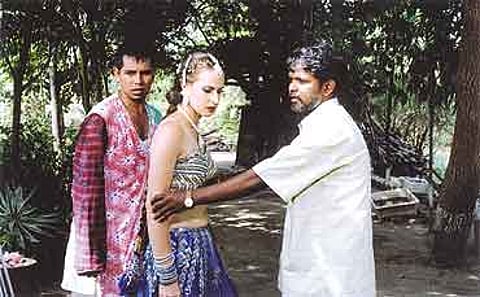Ab Hamar Film Hit Hoi
The flavour of the season is Bhojpuri. These small films rake it in where the mega-budget ones flop.
- Bhojpuri films are now regularly shot abroad. Narayan's production Kab Hoi Gauna Hamar was the first such film which was shot in Mauritius. Recently three films—Babul Pyaare, Dil Diwana Tohar Ho Gayi and Ganga—wrapped up an extended schedule in London. This week saw the release of Firangi Dulhania which isn't just shot abroad but also boasts of a Ukrainian actress, Tanya, in the lead role, a first for Bhojpuri films.
- Big daddy Bollywood is courting Bhojpuri. Thespian Dilip Kumar is producing a film with Ravi Kishan in the lead role, Amitabh Bachchan and Hema Malini are acting in Ganga, Raj Babbar stars in Babul Pyaare and Rati Agnihotri appears in Mat Bhulaiye Mai Baap Ke. Ajay Devgan has already done a guest appearance in a Bhojpuri film. Famous choreographer Saroj Khan is turning director with Dil Diwana Tohar Ho Gayi, action director Tinnu Verma is filming a remake of Mera Gaon Mera Desh and failed Bollywood heroines like Hrishitaa Bhatt and Preeti Jhangiani have found a new career in them.
- Bhojpuri films are also getting corporate backing. Vijay Mallya's film production unit is reportedly producing three Bhojpuri films. So is Ektaa Kapoor's Balaji Telefilms and AB Corp.
- Big Hindi films, like Namak Halal, are now being dubbed and re-released in Bhojpuri. A fight is on to get the dubbing rights of 30-40 films including Sholay and Deewar. Last heard, Fox was rumoured to be dabbling with the idea of dubbing Hollywood films into Bhojpuri.

The most significant shift is how the market for Bhojpuri films has gone way beyond Bihar and eastern UP. "The territory has started to grow," says Mehta. These films are doing well in Jammu, Kashmir, Jalandhar, Ludhiana, Panipat, Kurukshetra, Noida and Gurgaon which have a sizeable population of the migrant labour from Bihar. "It's the belt along the GT Road where the Bihar labourers have settled down," says Mehta. There is an estimated 40 lakh Bhojpuri-speaking population in Mumbai, 18 lakh in Punjab and about 8 lakh in Delhi. Bengal and Nepal are emerging as the next big markets.
Bhojpuri films tend to do very well in the industrial areas like Badarpur or the theatres in Thane in Maharashtra. Hindi films run for about three weeks there while Bhojpuri ones go on for 6-8 weeks. Recently Bandhan Toote Na completed 100 days in Bombay. "That's a dream run even for mainstream Bollywood," says Kishan. Mehta says about a dozen hole-in-the-wall theatres in Delhi depend entirely on Bhojpuri films for survival.
Bhojpuri films have also created a committed subset of loyal viewers within the growing nri audience. The films have found huge following in the diaspora in Fiji, Mauritius and the West Indies where, years ago, Biharis had gone as indentured labour. Udit Narayan thought of producing Kab Hoi... when he went for a show to Mauritius. "It was a small India. It was good to see how people had kept the Bhojpuri culture alive," he says. So through his period film, Kab Hoi..., set a century ago in Mauritius, he looked at the clash between the Britishers and sugarcane plantation labourers.
But at the very basic, the resurgence in Bhojpuri films has been because of mainstream Bollywood itself. In its quest for niche urban crowds and NRI audiences, Bollywood has steadily moved away from the non-metro masses. "The audience which pays Rs 20 for a film ticket is getting neglected, his sensibility is getting ignored," says Mehta. "A guy who wants to eat home-cooked food is being offered dishes from a five-star hotel, they are wasted on him," says Kishan. So, the thrust is towards homegrown subjects and a sense of rootedness, not technicolour fantasies. Much like the family socials of the '60s, the concerns are largely to do with marriage and family. "Devar, bhabhi, gauna. There's a native, Rajshree touch to these films," says Vinod Mirani, editor, Box Office. "Sindoor, mangalsutra and lots of emotions. We sell our culture and tradition than sex," says Kishan.
Another popular genre is the Govinda-David Dhawan kind of risque comedies complete with double entendres. But they have now begun experimenting with newer subjects. A satire on the political system, Banke Bihari MLA, is under way. "Soon we will have our own Manmohan Desai and Yash Chopra brand of cinema," says Kishan. Ironically, then the migrant labourer from Bihar and his Moti cinema hall will have to look for another kind of cinema to connect with.
Tags